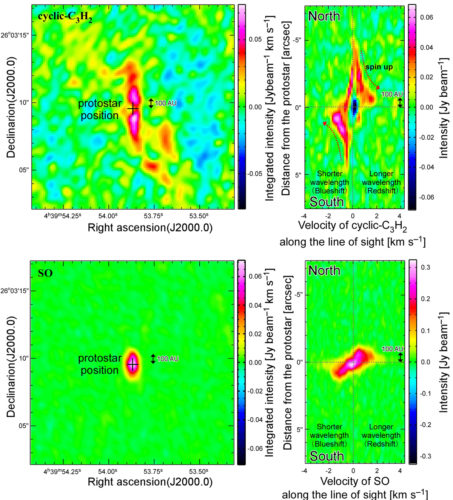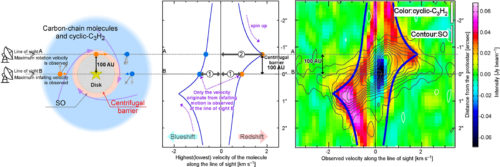Thanks to ALMA, astronomers discovered a drastic chemical change in the birth of a planetary system
So far, the interstellar matter was believed to be smoothly brought into a gas disk forming a planetary system as it is. Using the Atacama Large Millimeter/submillimeter Array (ALMA), a team led by Dr. Nami Sakai has been able to observe a drastic chemical change associated with the formation of the disk around the young protostar L1527 in the Taurus molecular cloud [1]. In-falling gas is jammed up due to centrifugal force around the outer edge of the disk, where local heating causes the drastic chemical change to happen. This discovery was published by Nature Journal with the title "Change in the chemical composition of in-falling gas forming a disk around a protostar" on february 12th, 2014.
A new star and its planetary system are formed through gravitational collapse of interstellar gas, mostly H2, and dust. Even after the birth of a protostar (a baby star), the gas and dust in the envelope are still in-falling onto it. At the same time, the gas disk grow up around the baby star, and eventually evolves into a planetary system. Until Dr. Sakai et al. work, formation processes of the gas disk as well as the associated chemical change were left unexplored by the observatories.
Dr. Nami Sakai, assistant profesor of physics in the University of Tokyo, and her global team, observed the young protostar L1527 in the Taurus molecular cloud at a high spatial resolution and high sensitivity with ALMA Observatory, newly constructed in the Atacama desert in Chile, and investigated the formation process of the disk in spectral lines of several molecules [2]. They discovered an unexpected chemical change in the transition zone between the in-falling envelope and the gas disk, contrary to what was believed so far to be a smooth delivery without any significant chemical change.

Figure 1. (top left): Integrated intensity distribution of the cyclic--C3H2 (523-432) line observed with ALMA. (top right) : The position velocity diagram of the cyclic-C3H2 (523-432) line along a north-south line passing through the protostar position. Frequency of the spectral line is shifted toward red (longer wavelength) and blue (shorter wavelength) when the molecule is moving away from us and moving toward us, respectively, due to the Doppler effect. Thus, the velocity can be measured by the frequency shift accurately, which is plotted in the diagram. The cyclic-C3H2 line is shifted to red in the north part of the protostar, whereas to blue in the south part. This means that we are looking at the rotating envelope from the edge-on direction. (bottom left) :Integrated intensity distribution of the SO (JN=78-67) line. The SO distribution seems to fill up the dip of the cyclic-C3H2 distribution. (bottom right): The position velocity diagram of the SO (JN=78-67) line along a north-south line passing through the protostar position. The velocity is proportional to the position offset from the protostar. This means that SO comes from a rotating ring with a cirtain radius as explained in Figure 2.
As a result of the observations, Sakai et al. have found that carbon-chain molecules [3] and their related species such as cyclic-C3H2 almost completely disappear in the gas phase inward of the radius of 100 AU from the protostar (figure 1, top left; top right). The motion of the gas was investigated on the basis of the precise measurement of the Doppler shift of their spectral lines, and it was revealed that the 100 AU radius corresponds to the centrifugal barrier [4] (figure 2). At this radius, in-falling gas is jammed up due to the centrifugal force, and is gradually transferred to the inner disk. Namely, this is the front of the disk forming region which has been clearly identified with the spectral line of cyclic-C3H2.

Figure 2.: (left) Schematic illustration of the infalling-rotating envelope around the protostar. The gas can not go inside the centrifugal barrier due to the centrifugal force. The observer is on the left-hand side, looking at the envelope in an edge-on configuration (middle) : The highest and lowest velocities of the infalling-rotating gas calculated from the model. The emissions of the colored closed circles come from the corresponding colored closed circles in the left panel. (right): The highest and lowest velocities shown in the middle panel are superposed on the position-velocity diagram of cyclic-C3H2. The observation of cyclic-C3H2. showes a beautifull agreement with the model. The cyclic-C3H2. molecules completely disappear at a radius of ~100 AU (the centrifugal barrier) from the protostar, whereas SO appears at the radius. SO preferentially exists in the ring whose radius is that of the centrifugal barrier.
On the other hand, the distribution of sulfur monoxide molecules (SO) is found to be localized in a ring structure located at the radius of the centrifugal barrier (100 AU) (Figure 1, bottom left; bottom right). Furthermore, the temperature of the SO molecules is found to be higher than the one of the in-falling gas. This means that the in-falling gas probably causes weak shocks when it inrushes into the outer edge of the disk around the centrifugal barrier. The gas temperature then raises around this radius, and the SO molecules frozen on dust grains are liberated into the gas phase. Hence, the spectral lines of SO also highlight the disk-formation front. Since the density of the disk happens to be 108cm-3 or higher, most of the molecules are frozen out onto dust grains in the disk after they pass through the front.
Hence, the chemical change associated to the disk formation have been successfully detected by the observation of two chemical species: cyclic-C3H2 and SO molecules. It was not anticipated at all that such a drastic chemical change occurred in the transition zone between the in-falling envelope and the inner disk.
This success was possible thanks to the high sensitivity and high spatial resolution capacity of ALMA. Therefore, the study will be extended toward various star-forming regions to examine how widely is applicable the phenomenon seen in L1527. This study novelty is the focus on the chemical change and, by extending this new method to various solar-type protostars, diversity and generality of the chemical evolution from interstellar matter to planetary matter could be unveiled within the next few yeas with ALMA, and finally critically examining whether the Solar System experienced the same drastic chemical change, tracing the origin of the matter found in microanalyses of meteorites and spectroscopy of comets.
Notes
[1] Molecular Cloud Core: A dense part of a molecular cloud, whose H2 density is higher than 104cm-3. It is gravitationally bound, and is a birth place of a new star. A typical size is 0.3 light years and a typical mass is 10 times the solar mass.
[2] Spectral Line: In this document, it means ‘rotational spectral line’, which is caused by the change in rotational energy levels by emitting or absorbing the electromagnetic radiation in the radio wavelength (millimeter and submillimeter wave regions). The rotational motion of a molecule is described by quantum mechanics, and has discrete energy levels. Frequencies of the rotational spectral lines of molecules are different from molecular species to molecular species, and we can definitively identify molecular species from observed spectral lines. The abundance of molecules as well as the H2 density and the temperature where the molecules reside can be derived from the observed intensity.
[3] Carbon-Chain Molecules: A group of molecular species in which carbon atoms have a linear configuration. Several series of carbon-chain molecules such as HCnN, CnH, CnH2, CnS y CnO are known as interstellar molecules. These are highly 'unsaturated' molecule having many mutiple bonds (double or triple bonds), and are chemically reactive in general. They are scarcely found in the terestrial conditions (density of 1019cm-3 and the temperature of 300 K), but are known to be abundant in interstellar clouds under the extreme physical condition (H2 density of 104-107 cm-3 and the temperature of 10-100 K). Its life time in interstellar clouds is typically a few times 105 years. In addition to the linear form, the isomers having a cyclic structure are also known. An example is cyclic C3H2.
[4] Centrifugal Barrier: When an infalling particle with conservation of its angular momentum is considered, the particle cannot go inward of the certain radius due to the centrifugal force. This is called as the centrifugal barrier, where the all kinetic energy is converted to the rotational energy. This is just a half of the centrifugal radius, where the centrifugal force and the gravitational force are balanced. The infalling gas is jammed up around the centrifugal barrier, and then a part of it will gradually be delivered into the inner disk by loosing the angular momentum.
More Information
The research findings are presented in the article Sakai et al. "Change in the chemical composition of infalling gas forming a disk around a protostar" published in the journal Nature, on February 12th, 2014.
The research team members are: Nami Sakai, Takeshi Sakai, Tomoya Hirota, Yoshimasa Watanabe, Cecilia Ceccarelli, Claudine Kahane, Sandrine Bottinelli, Emmanuel Caux, Karine Demyk, Charlotte Vastel, Audrey Coutens, Vianney Taquet, Nagayoshi Ohashi, Shigehisa Takakuwa, Hsi-Wei Yen, Yuri Aikaway and Satoshi Yamamoto
The Atacama Large Millimeter/submillimeter Array (ALMA), an international astronomy facility, is a partnership of the European Organisation for Astronomical Research in the Southern Hemisphere (ESO), the U.S. National Science Foundation (NSF) and the National Institutes of Natural Sciences (NINS) of Japan in cooperation with the Republic of Chile. ALMA is funded by ESO on behalf of its Member States, by NSF in cooperation with the National Research Council of Canada (NRC) and the Ministry of Science and Technology (MOST) in Taiwan and by NINS in cooperation with the Academia Sinica (AS) in Taiwan and the Korea Astronomy and Space Science Institute (KASI).
ALMA construction and operations are led by ESO on behalf of its Member States; by the National Radio Astronomy Observatory (NRAO), managed by Associated Universities, Inc. (AUI), on behalf of North America; and by the National Astronomical Observatory of Japan (NAOJ) on behalf of East Asia. The Joint ALMA Observatory (JAO) provides the unified leadership and management of the construction, commissioning and operation of ALMA.
Contact:
Dr. Nami Sakai
Department of Physics,
Graduate School of Science, University of Tokio
Tokio, Japan
Tel: +81 3-5841-4217
Fax: +81 2-5841-4178
E-Mail: [email protected]
Prof. Hiromi Yokoyama
Outreach Section,
Graduate School of Science, University of Tokyo
Tokio, Japan
Tel: +81 3-5841-8856
E-Mail: [email protected]
Nicolás Lira
Education and Public Outreach Assistant
Joint ALMA Observatory
Santiago, Chile
Tel: +56 2 467 6258
Cell: +56 9 75871963
E-mail: [email protected]
Masaaki Hiramatsu
Education and Public Outreach Officer, NAOJ Chile
Observatory Tokyo, Japan
Tel: +81 422 34 3630
E-mail: [email protected]
Charles E. Blue
Public Information Officer
National Radio Astronomy Observatory
Charlottesville, Virginia, USA
Tel: +1 434 296 0314
Cell: +1 434.242.9559
E-mail: [email protected]
Richard Hook
Public Information Officer, ESO
Garching bei München, Germany
Tel: +49 89 3200 6655
Cell: +49 151 1537 3591
Email: [email protected]


